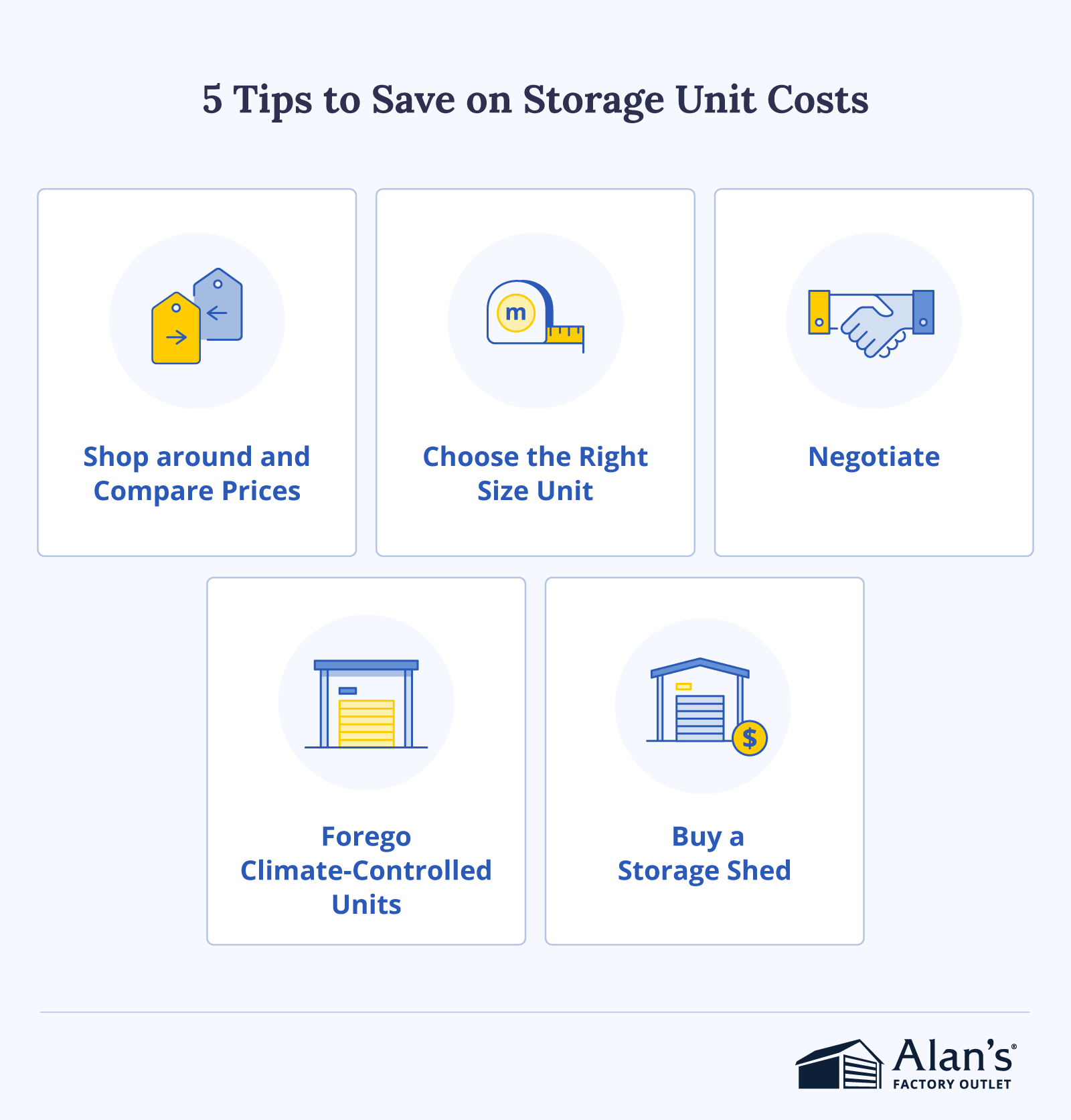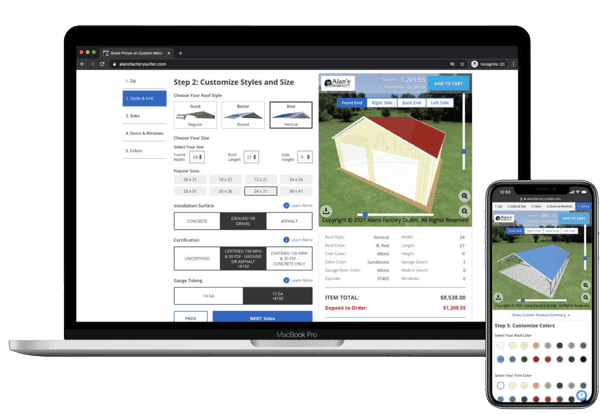The average storage unit costs $120 per month for a medium 10’×10′ space. However, prices can vary widely depending on location, square footage, and other features like climate control. Read on to learn how to reduce storage unit costs and discover cheaper alternatives.
Whether you’re moving to a new state or simply need extra space to keep your belongings, storage units are a popular solution. Over 20% of renters in the U.S. use self-storage facilities, where renting the average storage unit costs $120 per month.
This guide details the different costs and considerations that go into renting a storage unit, as well as alternatives like custom metal sheds that may be more affordable for long-term use.
Storage Unit Cost Breakdown
What you spend on self-storage rentals will mostly depend on the unit size you request, its availability where you live, and the facility you choose. Here is a breakdown to help you estimate storage unit costs for your individual needs.
By Size
The most popular storage unit size is 10 feet wide by 10 feet deep and costs $120 per month (about $1.20 per square foot), according to Storage Cafe.
Most storage facilities have several unit sizes available for rent. Climate-controlled units can be anywhere from 4% to 30% higher, depending on the unit size.
The table below provides standard storage unit sizes and square footage, along with the average price and cost per square foot for non-climate-controlled and climate-controlled units.
| Storage unit size | Average price: Not climate controlled* | Average price: Climate controlled* |
|---|---|---|
| 5×5 (25 sq. ft.) | $53 ($2.12/sq. ft.) | $54 ($2.17/sq. ft.) |
| 5×10 (50 sq. ft.) | $75 ($1.50/sq. ft.) | $84 ($1.68/sq. ft.) |
| 10×10 (100 sq. ft) | $120 ($1.20/sq. ft.) | $136 ($1.36/sq. ft.) |
| 10×15 (150 sq. ft.) | $158 ($1.05/sq. ft.) | $183 ($1.22/sq. ft.) |
| 10×20 (200 sq. ft.) | $195 ($0.98/sq. ft.) | $237 ($1.19/sq. ft.) |
| 10×30 (300 sq. ft.) | $258 ($0.86/sq. ft.) | $333 ($1.11/sq. ft.) |
*Source: StorageCafe
Note that the available units in a storage facility might not follow these standard sizes. For example, it’s not uncommon to see a 5×6 or 10×11 unit, along with various other sizes.
To ensure you’re getting a good comparison price, always look at the cost per square foot, not just the total cost. To do so, divide the square footage by the rental cost. For example:
$123 / 100 sq. ft. = $1.23/sq. ft.
This will give you a better idea of whether you’re getting a good deal. Generally, the cost per square foot will go down with larger unit sizes that have similar features.
If you’re not sure how much a storage unit holds based on size alone, this shareable chart displays an equivalent room size along with the most common types of items people store in units of each size.

By City and State
Location is another big factor that affects the cost of storage units. Prices will vary significantly from state to state, city to city, and even in different parts of the same city.
Below are the average costs to rent a storage unit in the five most and least expensive states.
| Most expensive storage states | Cheapest storage states |
|---|---|
| Hawaii: $137.12 | Oklahoma: $61.99 |
| Alaska: $122.31 | Arkansas: $62.23 |
| California: $112.19 | Indiana: $66.93 |
| New York: $102.95 | Wyoming: $68.36 |
| Washington: $97.08 | Washington D.C.: $78.18 |
Even within a state, storage unit prices are not evenly distributed. Major metropolitan areas can see much higher costs for storage units than other areas.
Below are some of the most expensive and least expensive cities to rent a storage unit in the U.S.
| Most expensive cities | Least expensive cities |
|---|---|
| San Rafael, CA: $308 | Denham Springs, LA: $55 |
| Santa Barbara, CA: $301 | Wilson, NC: $59 |
| Honolulu, HI: $297 | Gainesville, GA: $61 |
| San Francisco, CA: $289 | Huntsville, TX: $63 |
| Los Angeles, CA: $274 | Lawton, OK: $66 |
Source: StorageCafe
While bigger cities have more storage inventory than rural areas, there’s also high demand for storage units in New York, Chicago, Los Angeles, Miami, and other big cities. The real estate where storage facilities are built also costs more.
The table below shows the biggest metropolitan areas based on the number of storage units available.
| Metropolitan area | State(s) |
|---|---|
| Dallas, Fort Worth, Arlington | Texas |
| Houston, Pasadena, The Woodlands | Texas |
| New York City, Newark, Jersey City | New York, New Jersey |
| Los Angeles, Long Beach, and Anaheim | California |
| Atlanta, Sandy Springs, Roswell | Georgia |
| Chicago, Naperville, Elgin | Illinois, Indiana |
| Miami, Fort Lauderdale, West Palm Beach | Florida |
| Phoenix, Mesa, Chandler | Arizona |
| Riverside, San Bernardino, Ontario | California |
| Washington, Arlington, Alexandria | District of Columbia, Virginia, Maryland |
Rural areas have fewer overall storage units available, but people in those areas also have less need and a greater ability to create their own temporary storage solutions.
Vehicle Storage
Some storage units are created specifically for vehicle, boat, or RV storage. These are usually extra large units that may have special requirements on what can be stored in them.
Always be sure to check your rental agreement to make sure that you know what type of storage unit you have and what items can be put into it.
If you’re looking for long-term vehicle storage, a detached 2-car garage or 3-car garage may suit your needs better than off-site storage.
Additional Storage Unit Fees
The “average cost” of a self-storage unit typically refers to the monthly rent. However, additional fees may affect the overall cost of your unit.
Here are a few common fees to watch out for when looking at storage units:
- Administrative fee. This is usually a nonrefundable, one-time fee when you first rent your storage unit. Admin fees generally range from $10 to $25.
- Security deposit. Some facilities charge a security deposit as surety, while others may roll it into overall administration fees. Security deposits typically range from $50 to $100.
- Insurance. Many facilities require tenants to purchase storage insurance to protect their belongings. Rental insurance premiums range from $6 to $240 per month, depending on the provider and how much coverage you need.
- Late payment charges. These fees are imposed if you miss rent. Late payment fees can go as high as 20 percent of your monthly storage unit rent.
Factors Affecting Storage Unit Prices
In addition to base vs. total monthly fees for storage rentals, there are other factors that can influence the overall price.
- Climate Control. Units with HVAC systems will use more energy and, therefore, are more expensive than units without. However, they do help protect items from damage under extreme temperatures and humidity levels.
- Security Features. To keep valuables safe, storage facilities typically have gated access, security cameras, and individual unit alarms. These amenities will most likely increase the cost.
- Location in facility. Units can cost different depending on where they are located in the facility. For example, ground floor units with drive-up access might have a different price point than indoor units that require going up stairs or an elevator.
- Term Length. Shorter leases often come with a higher month-to-month rate since storage companies usually profit more from long-term rentals.
- Online deals. Vendors often run special rates on their websites that aren’t available if you rent your unit in the store. Examples include the first month free, a special web-only rate, or waived administrative fees.
- Taxes and Laws. Facilities can also legally raise their rates after your contract renewal, which may happen if regional taxes and utilities costs for them rise.
Long-Term Cost of a Storage Unit
A storage unit might be a good idea in the short term. But what if you need to store your belongings for an extended period of time?
The monthly cost of a 10×20 storage unit averages $195 without climate control. At that rate, the unit will cost $2,340 per year—or more if the monthly rate increases.
Compare that to a 12×20 detached garage or storage shed, which starts at $4,190 (without foundation). In less than two years, building a shed will more than make up for the cost of a storage unit of similar size, and that doesn’t even include the amount of gas, time, and energy you’ll save in trips to and from the storage facility.
Not everyone may have the space to build an on-site shed. But if you do, it’s worth considering the long-term cost savings a metal shed can offer.
5 Tips to Save on Storage Unit Costs
Now that you know how much you’ll pay for a storage unit, you can strategize ways to lower your monthly spending. The following tips can help you budget and save on storage unit expenses.

1. Shop Around and Compare Prices
Don’t settle for the first facility you find. Instead, get quotes from multiple storage facilities. Many offer online searching and quote tools so you can compare self-storage prices across different unit sizes and features.
When comparing storage options, consider factors like location, security features, and move-in/move-out fees. Also, check review sites and forums to compare amenities from customers’ perspectives.
2. Choose the Right Size Unit
Be careful not to rent more space than you need. Consider decluttering your garage or closets first to get rid of unused items.
If you decide you still need a storage space, take measurements of your furniture and boxes. Many storage facilities offer online sizing tools to help you visualize the right unit size.
3. Negotiate
Try to negotiate a lower rate, especially if you plan on renting a unit for a longer term. Many facilities are willing to offer a lower monthly rate for extended leases. You can also ask about promotions and discounts they may have, such as those for online bookings or discounts for military members, students, and seniors.
It’s also worth asking if the facility accepts proof of homeowners or renters insurance that covers items in storage to waive the storage insurance fee.
4. Forego Climate-Controlled Units
A climate-controlled storage unit is always more expensive than a unit without climate control. If your belongings can handle temperature fluctuations, getting a standard unit can help with major savings. This option is best for storing non-sensitive items like outdoor equipment, plastic furniture, and other items that won’t be bothered by temperature fluctuations.
5. Buy a Storage Shed
In some cases, owning a storage shed, like a large storage shed, is a more convenient and budget-friendly option than renting a storage unit. Depending on the rental rates and length of time you’ll need storage, the upfront cost for purchasing and installing a shed, over time, can be significantly cheaper than paying monthly rent.
Additionally, having a shed on your property gives you quick and around-the-clock access to your belongings. If you don’t have a garage, a shed is a great alternative for storing items that clutter or don’t quite fit inside your home.
Save Time and Money With a Customized Metal Storage Building
Storage unit rentals can come in handy if you travel often or need a temporary storage space for your belongings. But if you’ve simply run out of space in your home, incurring monthly storage fees is not the cheapest long-term solution.
Owning a storage building saves you money in the long run and helps you reclaim valuable space in your home. Best of all, you can design your metal shed with the exact size and features you need, rather than paying for a storage unit with too much space or not enough.
Check out our wide selection of high-quality storage sheds, find out the cost of a shed, and customize the perfect size and features for your needs.
FAQs About Storage Unit Costs
If you’re not quite sure whether the cost of a storage unit is worth it, these questions may have the answers you need.
Is it better to rent a storage unit or buy a shed?
Renting a storage unit can be a good short term solution. However, if you need long-term storage, building a shed may be more cost-effective in the long run. The best way to decide is to consider how long you’ll need the storage space, then average the cost over the number of months you’ll need it.
Keep in mind that the monthly price of a storage rental will increase over time, whereas the cost of building a shed will be spread out over a much longer time period.
Is paying for storage worth it?
Paying for storage may be worth the expense if you genuinely need it. However, there may be better or less expensive options to accomplish your goals.
Before paying for a storage unit, here are some other options to consider:
- Organize your storage space
- Throw away unneeded items
- Give your garage a makeover
- Consider a backyard shed
If these options don’t solve your storage problems, then a temporary storage unit might be a good idea. Consider starting with a storage locker or small storage unit before upgrading to something bigger to keep costs low.
Are storage pods cheaper than storage units?
No, in most cases renting a storage pod is not cheaper than renting a storage unit. However, the exact cost will depend on where you live and the availability of either pods or units. Some other disadvantages of storage pods is that there are fewer size options, there are no climate control options, and they may violate local codes or HOA rules.
However, a storage pod could still be a good option for convenience, especially for a move, renovation, or other short-term storage needs. For longer-term storage, a metal shed or garage will likely be a less expensive option than either storage pods or self-storage units.




